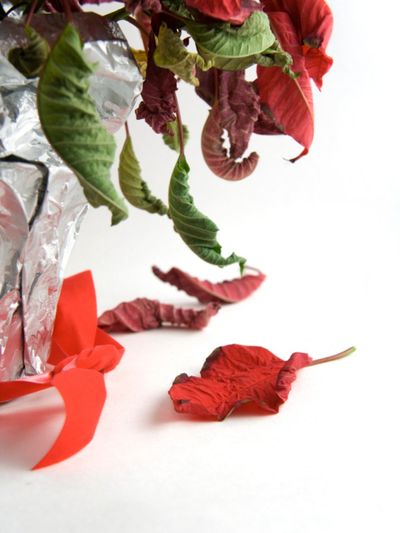The very act of carrying in your new poinsettia plant during the winter months can cause it to have foliar problems. Poinsettia leaves shrivel and die in incorrect temperatures. These cold-sensitive plants do not tolerate fluctuations in temperature and respond by shriveling and dropping leaves. Treating a shriveling poinsettia starts with the diagnosis of the problem, and then with methodical treatment measures and patience.
Diagnosing a Poinsettia with Shriveled Leaves
Cold damage, under watering, and changes in other site conditions will shock the plant, and poinsettia leaves shrivel and die. In most cases, correcting the conditions and waiting for a while will return the plant back to health. Fungal disease issues, however, may require the complete removal of the plant. These form in warm, moist conditions and may be harbored in the soil, borne in the air, or simply have come with the plant from the nursery. Removal of infected plant debris is the first defense followed by repotting in uninfected soil. To identify the exact type of disease, you will need a diagnostic of the common causes of a shriveled poinsettia plant.
Fungal Causes of a Poinsettia with Shriveled Leaves
Fungal diseases can attack the foliage, stems, and roots of a plant.
When stems are dark and discolored followed by foliage damage, Rhizoctonia may be the problem. Water-soaked foliage that eventually curls and dies may be the result of Rhizopus, a fungus that also attacks the stems and bracts. Scab or spot anthracnose starts with lesions on the foliage followed by curled leaves that succumb and die.
There are many other fungal diseases that can result in the leaves on poinsettias shriveling and dying. The important thing to remember is the conditions that cause these fungi to thrive. Crowded plants with little air circulation, overly wet soil, overhead watering, and warm moist temperatures encourage spore growth and formation.
Treating a Shriveled Poinsettia
Once you are fairly certain if the causes of your shriveled poinsettia plant are cultural, environmental, or disease-related, adjust your method of care to encourage better growth.
The plants need sunny, well-lit areas with warm temperatures. Keep the plants away from extremes such as cold, drafty windows or hot heat registers. Water only from the base of the plant when the soil feels dry to the touch and don’t allow the roots to sit in stagnant water. Remove any dropped leaves immediately so possible fungal issues do not spread. Fertilize every 2 weeks with a diluted liquid fertilizer. Use a fungicidal soil drench in extremely infected plants. If all else fails and the plant doesn’t recover, discard it and disinfect the area it was kept in to prevent spreading the fungus to other indoor plants.
